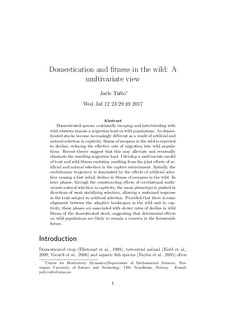Domestication and fitness in the wild: A multivariate view
Journal article, Peer reviewed
Submitted version
Permanent lenke
http://hdl.handle.net/11250/2465082Utgivelsesdato
2017Metadata
Vis full innførselSamlinger
- Institutt for matematiske fag [2397]
- Publikasjoner fra CRIStin - NTNU [37703]
Sammendrag
Domesticated species continually escaping and interbreeding with wild relatives impose a migration load on wild populations. As domesticated stocks become increasingly different as a result of artificial and natural selection in captivity, fitness of escapees in the wild is expected to decline, reducing the effective rate of migration into wild populations. Recent theory suggest that this may alleviate and eventually eliminate the resulting migration load. I develop a multivariate model of trait and wild fitness evolution resulting from the joint effects of artificial and natural selection in the captive environment. Initially, the evolutionary trajectory is dominated by the effects of artificial selection causing a fast initial decline in fitness of escapees in the wild. In later phases, through the counteracting effects of correlational multivariate natural selection in captivity, the mean phenotype is pushed in directions of weak stabilizing selection, allowing a sustained response in the trait subject to artificial selection. Provided that there is some alignment between the adaptive landscapes in the wild and in captivity, these phases are associated with slower rates of decline in wild fitness of the domesticated stock, suggesting that detrimental effects on wild populations are likely to remain a concern in the foreseeable future.
